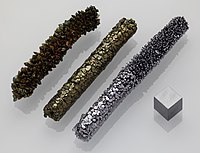
Photo from wikipedia
Abstract The monitoring of concentrations of metals in road dust can be used in evaluating vehicular contributions to the environment. Here we compare the efficacy of several analytical techniques for… Click to show full abstract
Abstract The monitoring of concentrations of metals in road dust can be used in evaluating vehicular contributions to the environment. Here we compare the efficacy of several analytical techniques for such samples: XRF, SEM/EDX and ICP-MS, providing for both qualitative and absolute quantitative analysis. To-date we have made evaluation of key elemental levels from roadside dust sampled at different locations within the University of Surrey and the Kuwait Research Institute, in so-doing also investigating the influence of engine size (Kuwaiti vehicles tending to be of larger engine capacity than those in the UK) and the influence of climate, maritime and arid in the present case. With a total of 36 street dust samples collected to-date, 18 have now been analyzed, elemental concentrations being reported for Mg, Al, Ti, Mn, Fe, Co, Zr, Mo, Ba, Tl, V, Rd, Pb, Cu, Zn, Ni, Cr, Cd, As, Hg and Au. For University of Surrey samples, obtained at three different times of the year, SEM/EDX findings range from below the lower limit of detection for Ag, through to 4.7 × 10−6 mg/m2 for Co, up to 3.6 × 10−2 mg/m2 for Fe. Using ICP-MS on sieved University of Surrey road dust samples similarly taken at different times of the year, mean particle dimensions
Journal Title: Radiation Physics and Chemistry
Year Published: 2019
Link to full text (if available)
Share on Social Media: Sign Up to like & get
recommendations!